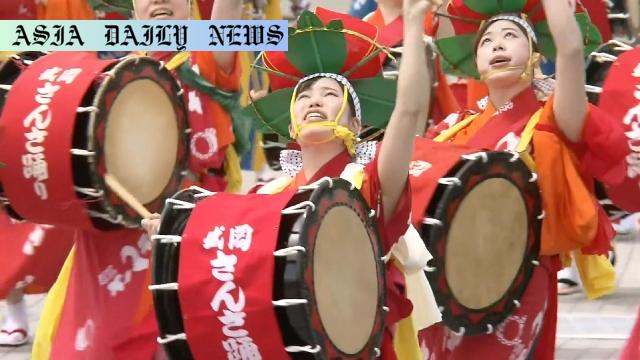Tohoku Festival highlights traditional summer festivals’ cultural vibrancy and recovery efforts at Osaka Expo.
- The Tohoku Kizuna Festival showcases six traditional summer festivals from northeastern Japan.
- Held at the Osaka Expo, the event expresses gratitude for domestic and international support after the 2011 earthquake and tsunami.
- Participants demonstrated unique performances, from balancing lantern-laden bamboo poles to carrying giant straw sandals.
- The festival’s goal was to highlight Tohoku’s cultural richness and its recovery progress to global audiences.

Introduction to Tohoku Kizuna Festival
The Tohoku Kizuna Festival is a remarkable annual event aimed at celebrating the rich cultural heritage of northeastern Japan while fostering community spirit and recovery efforts. Originating in the aftermath of the devastating 2011 Great East Japan Earthquake and tsunami, this festival brought together six major summer festivals from Tohoku’s six prefectures. Over the years, it has become a symbol of resilience, gratitude, and cultural pride. This weekend, a special edition of this event took center stage at the World Expo in Osaka, drawing the attention of a global audience.
Celebrating Culture and Recovery on a Global Stage
The festival at the Osaka Expo was nothing short of astounding. It featured 550 participants who proudly paraded through the venue, embodying Tohoku’s unique culture and traditions. Each of the six participating prefectures brought their own distinctive flavor to the celebration. For instance, Akita Prefecture captivated spectators with performers balancing 12-meter-tall bamboo poles, adorned with vibrant paper lanterns, on their shoulders and foreheads. This intricate act, requiring both skill and precision, was met with resounding applause from the audience.
Meanwhile, Yamagata Prefecture presented an enchanting display of dancers gracefully waving straw hats decorated with red flowers, highlighting the region’s artistic heritage. Fukushima Prefecture’s participants astonished onlookers by marching through the venue as they carried a massive 12-meter-long straw sandal. Each performance served not only as entertainment but as a heartfelt tribute to the global support that helped shape the region’s recovery over the last decade.
The Significance of the Festival
This year’s iteration of the Tohoku Kizuna Festival held particular significance, as it showcased the resilience and recovery of the northeastern region of Japan. The festival allowed locals to share their progress and remind the global community of the long-lasting impact of international aid. The event was a testament to how cultural preservation and resilience go hand in hand as a community’s heartbeat.
The festival’s name, “Kizuna,” which translates to “bond,” underscores the deep connections between Tohoku and those who extended their help during their time of need. It emphasized the idea that culture is both a source of strength and a bridge of understanding, allowing Tohoku to share its gratitude and growth journey with audiences around the world.
Key Performances: A Closer Look
Akita’s bamboo-pole lantern balancing, Yamagata’s delicate straw-hat dances, and Fukushima’s monumental straw sandal were just some of the incredible highlights of the festival. But what set this event apart was the way these performances embodied the distinctive characteristics of each prefecture. These weren’t simply displays of tradition—they were heartfelt expressions of community identity and persistence in the face of adversity.
The carefully organized performances were designed to evoke hope and pride among spectators, igniting feelings of admiration for Tohoku’s journey of recovery. By including these symbolic acts, festival organizers ensured that each moment resonated with cultural richness and historical context, deepening the understanding of Japan’s diverse heritage.
Conclusion: A Celebration of Strength and Culture
The Tohoku Kizuna Festival at the Osaka Expo was more than just an event—it was a vivid tapestry of hope, resilience, and gratitude. By showcasing vivid and meaningful elements of its traditions, northeastern Japan reminded the world of its cultural treasures and the enduring spirit of its people. As the festival wrapped up, it left visitors and participants alike with a renewed appreciation for Tohoku’s rich heritage and a poignant reminder of how culture and community can serve as powerful tools for healing and unity.



Commentary
A Tribute to Resilience through Culture
The Tohoku Kizuna Festival is a shining example of how communities can come together to celebrate their culture amid adversity. After the tragic 2011 Great East Japan Earthquake, Tohoku’s recovery was not just about rebuilding infrastructure—it was also about preserving and revitalizing its cultural identity. This festival plays a crucial role in achieving that goal. Its presence at the Osaka Expo signifies more than just a performance; it represents the resilience and strength of an entire region and its people.
The Power of Unity in Diversity
What makes the Tohoku Kizuna Festival particularly remarkable is its celebration of the unique traditions of six different prefectures. From the dazzling lantern-balancing acts of Akita to the intricate straw-hat dances of Yamagata and the awe-inspiring sandal display by Fukushima, every performance highlights a different facet of Tohoku’s rich cultural tapestry. These diverse acts remind us of the beauty and importance of unity in diversity, as each prefecture’s unique contribution adds to the overall narrative of resilience and gratitude.
Global Recognition and Cultural Diplomacy
The festival’s inclusion at the Osaka Expo also showcases the important role of cultural preservation in global diplomacy. By bringing these traditional performances to an international stage, the Tohoku region not only expressed its gratitude for global support but also strengthened cross-cultural understanding. Events like this remind us that culture can transcend borders, becoming a universal language that fosters empathy, connection, and shared humanity. It is a poignant reminder of how art and tradition can serve as powerful tools for healing and collaboration across the globe.